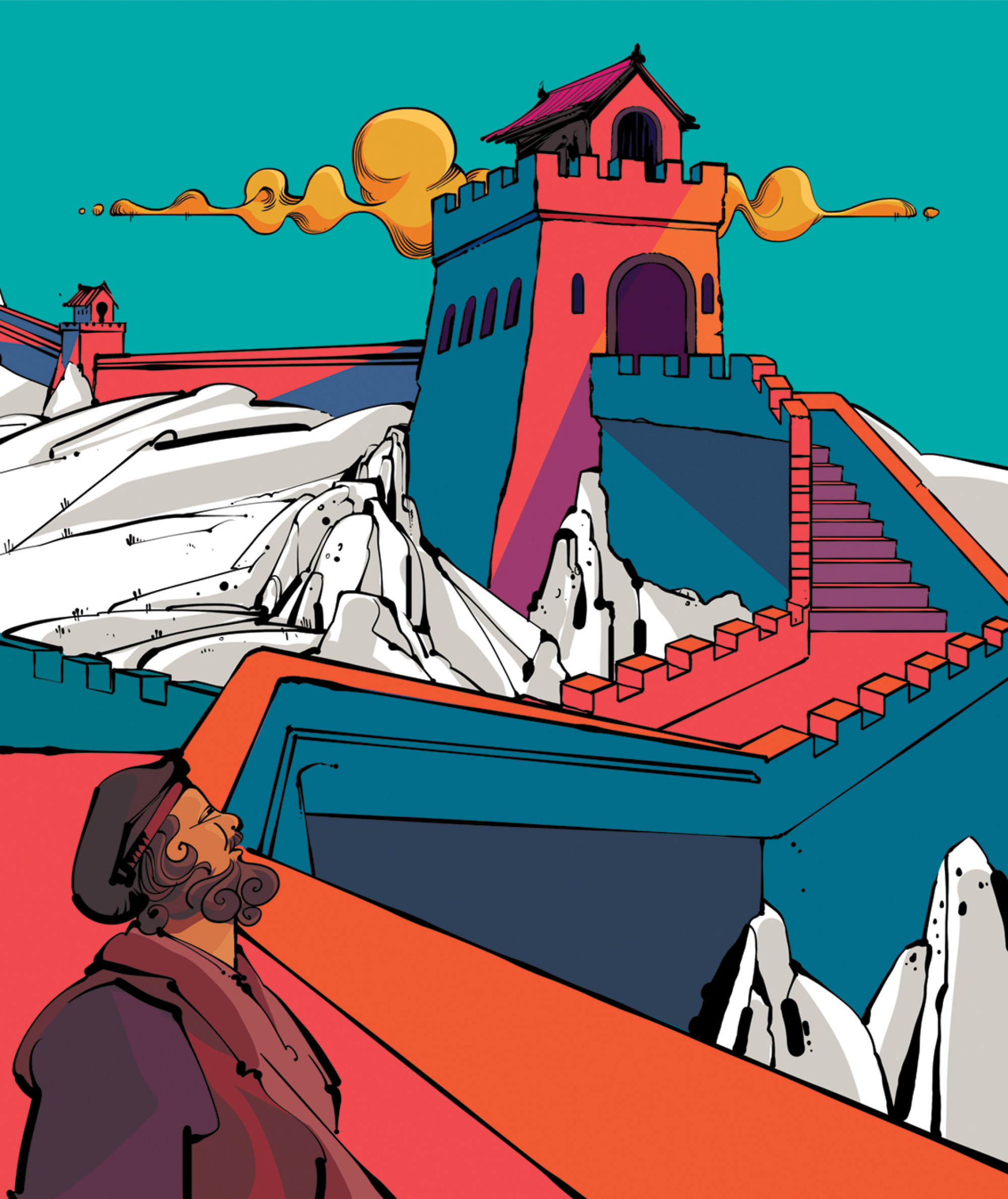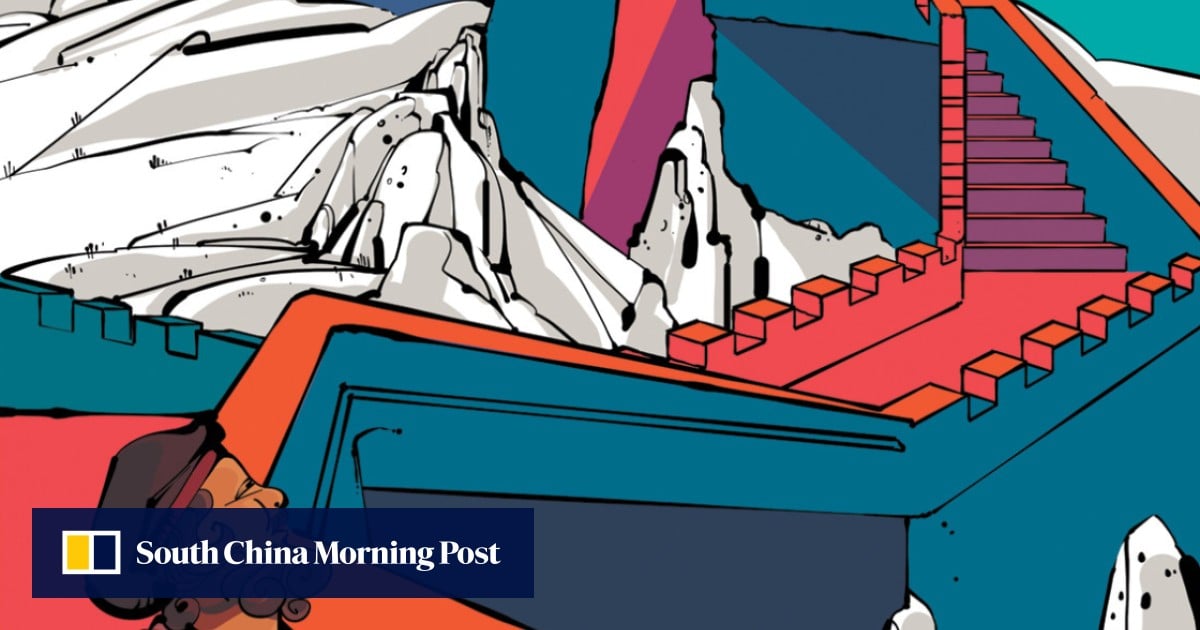Extracted from The Light of Asia: A History of Western Fascination with the East by Christopher Harding, published by Allen Lane, January 2024
***
“Honoured emperors and kings, dukes and marquesses, counts, knights and townspeople, and all who want to know about the various races of mankind and the peculiarities of the various regions of the world, take this book and have it read to you!
“Here you will find all the greatest wonders and chief curiosities of Greater Armenia and Persia, of the Tartars and India, and of many other lands. Our book will lay them out for you in the proper order as related by Messer Marco Polo, a wise and noble citizen of Venice, who has seen them with his own eyes.”
Roll up, roll up … When recited aloud, as they were intended to be, the opening lines of The Description of the World – better known as The Travels of Marco Polo – have the feel of a stallholder hawking his wares. And well they might: this was retail of a kind, part of a broader commercial revolution.
By the time of Marco Polo’s birth, in 1254, his home city of Venice had gone from being a client state of the Byzantine Empire to a formidable maritime and trading power in its own right, dominating much of the Adriatic and Aegean and capable of capitalising on Byzantine weakness and the upheaval of the Crusades.
Polo’s co-author, Rustichello, was a romance writer from a second maritime republic, Pisa, and the two men met in a jail located in a third: Genoa.
These were the three greatest of a handful of Italian maritime republics, which, alongside cities such as Marseille and Barcelona, were by this time sending merchants to spice markets, including those of Alexandria.
Where the maritime republics had grown rich trading everything from spices to slaves, Polo and Rustichello’s product was stories – true stories, mind you: by far the most detailed and (they insisted) trustworthy account of Eastern lands and peoples ever to be offered up to European eyes and ears.
Europeans setting out for the East in this era did not need to begin their journeys with a trudge through eastern Europe. One could sail the Mediterranean Sea, pass through Constantinople to cross the Black Sea, and from there continue overland either north or south of the Caspian Sea.
This would bring you to one of the starting points for the trans-Asian routes opened up by Mongol conquests. According to The Travels, this was how Marco Polo’s father, Niccolò, and his uncle, Maffeo, made it all the way to the court of Kublai Khan around 1260 – located perhaps, at this point, in his emerging capital, Daidu (present-day Beijing).

Having interrogated the pair, Kublai sent them back to Europe as his emissaries to the pope, demanding that they return to his court along with 100 Christian scholars and a vial of holy oil from the Church of the Holy Sepulchre in Jerusalem.
Niccolò and Maffeo did their best, arriving at Kublai’s summer palace in northern China in 1273 or 1274, not with 100 scholars but with two friars sent by the pope – plus Niccolò’s teenage son, Marco.
The three Polos supposedly remained in Asia until the early 1290s. Marco spent around 17 years serving as an administrator and emissary for Kublai Khan, developing a good claim to be the first European to travel widely in China and the first ever to see Indochina.
The surprisingly brief existence of the ancient Silk Road
The surprisingly brief existence of the ancient Silk Road
Afterwards, during the three men’s long journey home, they became the first known Europeans to visit Sumatra, some of the first in many centuries to visit India – alongside the Italian Franciscan missionary John of Montecorvino, who spent a year in south India around the same time that the Polos were there – and the first to report the existence of a great number of small spice-producing islands.
Marco Polo arrived home in 1295, but three years later he was captured in a sea battle between the Venetians and the Genoese.
He used his jail time to dictate to his fellow inmate Rustichello some of the details of what he had spent the past 20 or so years doing and seeing.

Not everyone in Europe believed what they read when manuscript copies of The Travels began to do the rounds. Some of Polo’s own friends apparently urged him, on his deathbed, to recant any lies or exaggerations while he still had time. And for a long while after it emerged, the book was regarded as a romance rather than a travel account.
They were upset, too, by Polo’s debunking of cherished ideas. Unicorns, he claimed, were not magical beasts who would let themselves be caught by virgins; in fact, they were “very ugly”, with hair like buffalo, and they loved to wallow in mud (Polo seems to have been describing a rhinoceros).
There were no pygmies in India, as some liked to imagine, just some “very small monkeys with a face like a man’s”.

Polo undoubtedly gilded the lily, abetted by Rustichello. He almost certainly did not serve as governor of a Chinese city, as The Travels claimed. Nor did he supply foreign engineers to create siege-breaking trebuchets – the siege in question was long over by the time he arrived at Kublai’s court.
But the Great Wall was not a noteworthy, imposing structure in Polo’s day. And too much discussion of Chinese customs might have been considered improper when Polo’s boss, Kublai Khan, had just brought the Song dynasty to an end and was busy creating a new, Mongol dynasty (the Yuan) in its place.
Most now agree that Polo did indeed go to China, travelling far and wide and furnishing his audiences with generally reliable information – if sometimes exaggerated – about its rivers and canals, natural resources, architecture and industries.
Polo described at length the wonders of Xingzai (Hangzhou): an immense trading city of wide and airy streets, squares and canals. To its markets, people brought fish, deer, rabbits, partridges, ducks and geese, alongside vegetables and fruits of all kinds.
Nobles and magistrates built their homes on the banks of a “crystal-clear freshwater lake”. In the centre of that lake lay two islands, on each of which stood “a truly marvellous and sumptuous palace with more rooms and apartments than can be imagined”. Parties were held there, sometimes 100 at once, while in the surrounding waters people enjoyed pleasure cruises on boats and barges, large and small.

There is no reason that Polo’s account of travelling in India, too, ought not to be believed, at least in outline.
His travels there were facilitated, it seems, by a combination of Mongol and Muslim maritime power, alongside the Arabic and Persian languages: Polo made heavy use of Arabic place names in his Travels, and while he spoke no south Indian languages he could probably get by in Persian. This would have allowed him to pick up stories and explanations about India from Muslim interlocutors.
In other ways, Polo’s relative lack of formal education, having left Europe while still a young man, may have played in his favour. Rather than clogging The Travels with classical references (he mentions Alexander the Great, but not Megasthenes or Pliny), Polo offered raw observation.
He perhaps developed the habit while serving as an envoy of the Great Khan, having witnessed first-hand the perils of disappointing him with insufficiently comprehensive information.
Even on matters of religion, Polo rarely sought to judge or compare. He was happy to pass on to his readers Kublai Khan’s scepticism about Christianity and Christians: “ignorant [people who] make nothing of themselves and have no power”. And he suggested of the Buddha, about whose life Polo discovered a little on his travels, that “if he had been a Christian, he would undoubtedly be a great saint and dwell with our Lord Jesus Christ”.

It was perhaps in a similar spirit of openness to being entertained that European readers would have considered another unlikely sounding claim from Polo: “Cipangu is an island that lies out to the east [of China] in the open sea, 1,500 miles from the mainland. It is an exceptionally large island. The people are white, good-looking and courteous. They are idolaters and are completely independent, having no rulers from any race but their own.
“Moreover, I can tell you that they are exceedingly rich in gold, because it is found here in inestimable quantities. You may take my word for it that [the ruler of the island] has a huge palace entirely covered with fine gold.
“In the same way that we proof our houses and churches with lead, so this palace is roofed with fine gold … [All] the chambers, of which there are many, are likewise paved with fine gold to a depth of more than two fingers. And all the other parts of the palace, including the halls and the windows, are likewise adorned with gold.
“I assure you that this palace is of such incalculable richness that anyone who tried to estimate its value would find it too staggering for words.”
Polo goes on to claim that these people possess both black and white pepper, alongside “pearls in abundance”. Less happily, they are given to “outlandish and diabolical [exploits] … wickedness [that] would be too much for Christian ears”. Polo is, of course, going to describe it anyway.
Did Chinese emperor identify as a woman like Roman emperor Elagabalus?
Did Chinese emperor identify as a woman like Roman emperor Elagabalus?
Their captive is the main item on the menu. Cooked in a manner unspecified, their flesh is considered to be “the finest food in existence”. Yet more tasty morsels from the mind of Rustichello – or something else?
A careful reader of – or listener to – The Travels might have noticed that whereas elsewhere in his account Polo was keen to present the “Great Khan” in the best possible light, when it came to Cipangu he felt bound to relate an embarrassing episode.
Upon hearing of that country’s great wealth, the Great Khan had resolved to conquer it. “A huge fleet of ships carrying cavalry and infantry” was put to sea under the command of two of his men. But great winds arose, wrecking some of the ships and scattering the rest, leading ultimately to the failure of the mission and the execution of its leaders.
Sceptics might dismiss as yet more fabulation the claim of a marvellous island protected by powerful winds. But Marco Polo had just widened their world for them, putting Japan on the map.







